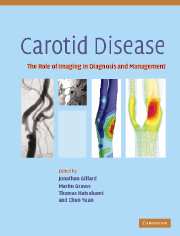Book contents
- Frontmatter
- Contents
- List of contributors
- List of abbreviations
- Introduction
- Background
- 1 Pathology of carotid artery atherosclerotic disease
- 2 Epidemiology of carotid artery atherosclerosis
- 3 Genetics of carotid atherosclerosis
- 4 Hematological processes in emboli formation
- 5 Medical treatment for carotid stenosis
- 6 Surgical management of symptomatic carotid disease: carotid endarterectomy and extracranial-intracranial bypass
- 7 Surgery for asymptomatic carotid stenosis
- 8 Interventional management of carotid disease
- Luminal imaging techniques
- Morphological plaque imaging
- Functional plaque imaging
- Plaque modelling
- Monitoring the local and distal effects of carotid interventions
- Monitoring pharmaceutical interventions
- Future directions in carotid plaque imaging
- Index
- References
8 - Interventional management of carotid disease
from Background
Published online by Cambridge University Press: 03 December 2009
- Frontmatter
- Contents
- List of contributors
- List of abbreviations
- Introduction
- Background
- 1 Pathology of carotid artery atherosclerotic disease
- 2 Epidemiology of carotid artery atherosclerosis
- 3 Genetics of carotid atherosclerosis
- 4 Hematological processes in emboli formation
- 5 Medical treatment for carotid stenosis
- 6 Surgical management of symptomatic carotid disease: carotid endarterectomy and extracranial-intracranial bypass
- 7 Surgery for asymptomatic carotid stenosis
- 8 Interventional management of carotid disease
- Luminal imaging techniques
- Morphological plaque imaging
- Functional plaque imaging
- Plaque modelling
- Monitoring the local and distal effects of carotid interventions
- Monitoring pharmaceutical interventions
- Future directions in carotid plaque imaging
- Index
- References
Summary
Surgical trials and the role of surgery
Stroke is the third most common cause of death in the Western world, and atherosclerotic stenosis of the carotid artery, close to the carotid bifurcation in the neck, causes about 10% of all strokes and transient ischemic attacks (TIA) (Clifton, 2002). For patients who have had recent symptoms associated with severe carotid stenosis the additional risk of stroke over the next 2 years is thought to be 20% or more if patients are treated medically and is thought to be greater in patients with very severe stenosis (Dennis et al., 1990). It may be as high as 28% (North American Symptomatic Carotid Endarterectomy Trial Collaborators, 1991). Recent studies have shown, however, that the risks may be greater. The Oxford Community Stroke Project showed that much data looks at risk of stroke from either the date seen by a neurologist or from the date referred to at TIA service. They showed that the risk of stroke from the date of the first ever TIA was much greater in the first 30 days, in the region of 12%+ (Coull et al., 2004). It has also been shown that the odds of having a stroke when the patient is found to have large artery disease, i.e. significant carotid stenosis, is much greater than if the cause is found to be secondary to small vessel disease or cardiac embolism (Lovett et al., 2003).
Keywords
- Type
- Chapter
- Information
- Carotid DiseaseThe Role of Imaging in Diagnosis and Management, pp. 94 - 104Publisher: Cambridge University PressPrint publication year: 2006

